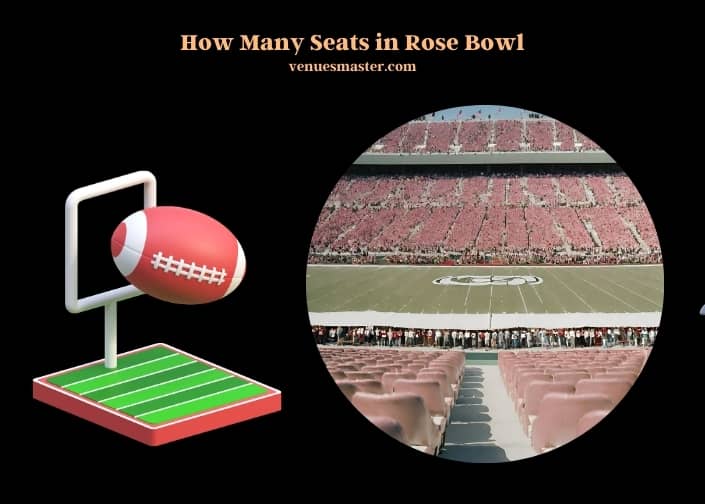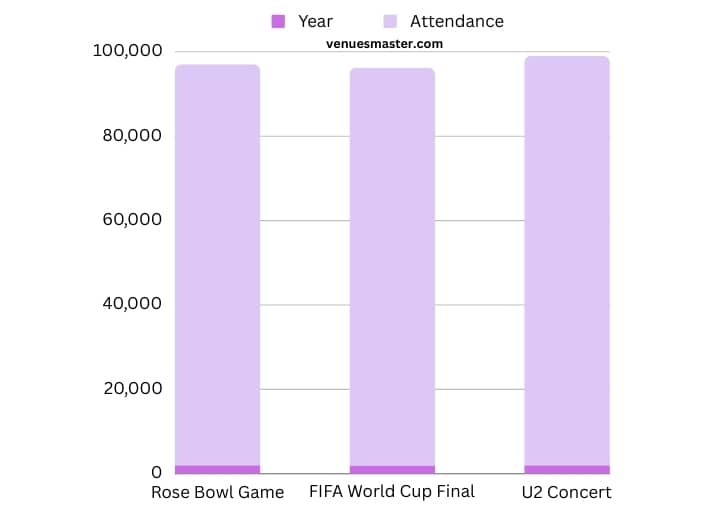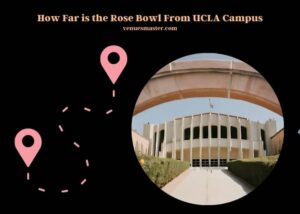Published on: 21 December 2023
Written by Najrul / Fact-checked by Asma Abir
The Rose Bowl Stadium in Pasadena, California, has a seating capacity of 92,542. This iconic venue, known for hosting college football games, especially the annual Rose Bowl Game, is a landmark in American sports history.
The Rose Bowl Stadium, with its vast seating capacity, stands as one of the largest stadiums in the United States. Built in 1922, it has undergone several renovations to maintain its grandeur and accommodate modern needs. Its design is unique, featuring a circular shape that ensures an unobstructed view from every seat. This architectural feature enhances the spectator experience, making it a favorite venue for fans.
Apart from college football, the Rose Bowl has been a versatile venue, hosting events like the FIFA World Cup Finals, concerts, and the Olympic Games. Its significance extends beyond sports; it’s a cultural symbol, representing American enthusiasm for collegiate sports and large-scale events. The stadium’s history is rich, marked by memorable games and performances that have left a lasting impact on visitors and viewers alike.
The Rose Bowl is not just a stadium; it’s a testament to American sports culture. Its large seating capacity is a reflection of the immense popularity of the events it hosts. For those interested in learning more about this historic venue, the detailed article below offers an in-depth look at its history, architecture, and the iconic events it has hosted over the years.
How Many Seats in Rose Bowl?

The History of the Rose Bowl Stadium
Origins and Early Years
Let’s take a trip back in time to the early 1920s, when the Rose Bowl Stadium first opened its doors. Nestled in Pasadena, California, this stadium started as a modest venue but quickly became a cornerstone of American sports. Its creation was driven by the need for a larger space for the increasingly popular Rose Bowl Game, part of the annual Tournament of Roses since 1902.
Key Milestones in Development
Over the years, the Rose Bowl has seen significant changes. From hosting its first game in 1923 to undergoing major renovations, each milestone has been a step towards making it the iconic venue it is today. It’s not just a stadium; it’s a piece of history that has evolved with time, reflecting the changing dynamics of American sports and entertainment.
Architectural Design and Seating Layout
Overview of Stadium Design
The Rose Bowl’s design is a marvel in itself. Its circular shape, an architectural choice, ensures that every spectator gets a clear view of the field. This design isn’t just about aesthetics; it’s about enhancing the experience of every person who walks through its gates, making sure they’re part of the action no matter where they’re seated.
Seating Arrangement and Visibility
Speaking of seats, the arrangement in the Rose Bowl is something to talk about. The stadium’s layout is designed to maximize visibility, ensuring that each of the 92,542 seats offers a great view. This thoughtful design is one of the reasons why it’s such a sought-after venue for various events.
Comparison of Seating Layouts Over the Years
| Year | Seating Layout |
| 1922 | 57,000 |
| 1949 | 100,807 |
| 1972 | 104,594 |
| 1998 | 92,542 |

Seating Capacity Through the Ages
Initial Seating Capacity and Early Expansions
When the Rose Bowl first opened, it could seat 57,000 spectators. But as its popularity grew, so did its capacity. The stadium underwent several expansions in the following decades to accommodate more fans, reflecting its growing significance in American sports culture.
Recent Renovations and Current Capacity
The most recent renovation in 1998 brought the capacity down to 92,542. This reduction was a strategic move to improve safety and comfort, showing that the Rose Bowl values quality over quantity. It’s not just about how many people can fit in; it’s about ensuring a memorable and safe experience for everyone.
Chronological Changes in Seating Capacity
| Year | Seating Capacity |
| 1922 | 57,000 |
| 1949 | 100,807 |
| 1972 | 104,594 |
| 1998 | 92,542 |
Notable Events Hosted at the Rose Bowl
College Football Highlights
The Rose Bowl is synonymous with college football. It’s the heart of the action every New Year’s Day, hosting the Rose Bowl Game. This event isn’t just a game; it’s a tradition that has been drawing crowds for decades, showcasing some of the best talents in college football.
Other Major Sporting Events
But football isn’t the only sport that shines here. The Rose Bowl has hosted five Super Bowls, the 1994 FIFA World Cup Final, and the 1999 FIFA Women’s World Cup Final, among others. Each event has added to the stadium’s legacy, making it a versatile venue for various sports.
Concerts and Cultural Gatherings
The Rose Bowl’s appeal extends beyond sports. It’s a popular venue for concerts and cultural events, having hosted legendary artists and bands. These events have not only entertained thousands but have also added a rich cultural dimension to the stadium’s history.
Attendance Figures for Major Events
| Event | Year | Attendance |
| Rose Bowl Game | 2023 | 95,000 |
| FIFA World Cup Final | 1994 | 94,194 |
| U2 Concert | 2009 | 97,014 |

The Rose Bowl in Popular Culture
Appearances in Films and Television
The Rose Bowl isn’t just famous in the sports world; it’s a star in films and TV shows too! Its unique structure and historical significance have made it a go-to location for filmmakers, adding a touch of authenticity and grandeur to various productions.
Symbolism in American Sports Culture
More than just a stadium, the Rose Bowl is a symbol of American sports culture. It represents the passion and spirit of American sports, standing as a testament to the country’s love for football and large-scale events. It’s not just a place; it’s a part of the American identity.
Economic and Community Impact
Influence on Local Economy
The Rose Bowl is a major player in the local economy. Every event it hosts brings in thousands of visitors, boosting local businesses and contributing significantly to the economy of Pasadena and the surrounding areas.
Community Engagement and Events
But it’s not all about the money. The Rose Bowl also plays a vital role in community engagement. From local sporting events to community gatherings, it’s a hub of activity that brings people together, fostering a sense of community and belonging.
Environmental Sustainability and Modernization
Sustainability Initiatives
In today’s world, sustainability is key, and the Rose Bowl is on board with this. The stadium has implemented various eco-friendly initiatives, aiming to reduce its environmental footprint and promote sustainability in its operations.
Technological Advancements and Future Plans
The Rose Bowl is also keeping up with technological advancements. From modernizing its facilities to incorporating the latest tech for better fan experiences, it’s a stadium that’s not just resting on its laurels but is actively preparing for the future.
Frequently Asked Questions (FAQs)
What Is the Maximum Capacity the Rose Bowl Has Ever Held?
The Rose Bowl’s maximum capacity reached its peak in 1972, accommodating an impressive 104,594 spectators. This record-setting number was a result of several expansions and renovations aimed at increasing the stadium’s capacity to host larger crowds. Over the years, the Rose Bowl has been a venue for numerous high-profile events, each demanding more space for spectators. The 1972 expansion was a significant milestone, reflecting the stadium’s growing popularity and its ability to host large-scale events.
This capacity was later reduced to prioritize comfort and safety, balancing the need for a large audience with the quality of the spectator experience.
How Does the Rose Bowl’s Seating Capacity Compare to Other Major Stadiums?
When compared to other major stadiums, the Rose Bowl’s seating capacity of 92,542 places it among the largest in the United States. For instance, Michigan Stadium, also known as “The Big House,” has a capacity of over 107,000, making it the largest stadium in the U.S. and the second-largest in the world. The Beaver Stadium at Penn State follows closely, with a capacity of around 106,000. While the Rose Bowl doesn’t top this list, its capacity is still significant, especially considering its age and historical value. This capacity allows it to host a wide range of events, from sports to concerts, making it a versatile and sought-after venue.
What is the Seating Capacity of the Rose Bowl Compared to the Coliseum?
The seating capacity of the Rose Bowl is 92,542, while the Coliseum has a capacity of 77,500. When comparing rose bowl vs coliseum, it’s clear that the Rose Bowl has a significantly higher seating capacity, making it one of the largest stadiums in the United States.
Can I Park at the Rose Bowl if I Attend an Event with the Maximum Seating Capacity?
If you are attending an event at the Rose Bowl with its maximum seating capacity, it’s essential to consider your rose bowl parking options ahead of time. Plan your parking strategy to ensure a hassle-free experience as the parking lots can fill up quickly during large events.
Are There Plans to Increase the Rose Bowl’s Seating Capacity in the Future?
As of my last update in April 2023, there were no publicized plans to significantly increase the Rose Bowl’s seating capacity. The focus in recent years has been more on modernizing the stadium and enhancing the overall experience for visitors rather than expanding its size. This includes upgrading facilities, improving safety measures, and incorporating technological advancements. The stadium’s management seems to prioritize maintaining the historical integrity and ensuring the comfort and safety of its patrons over increasing its capacity. Any future expansions would likely consider these factors, along with the logistical and environmental impacts of such a project.
How Does the Seating Capacity Impact the Atmosphere During Events?
The seating capacity of the Rose Bowl, currently at 92,542, significantly impacts the atmosphere during events. A large crowd can create an electrifying and vibrant environment, especially during high-stakes games like the Rose Bowl Game or major concerts. The roar of tens of thousands of fans adds to the excitement and intensity of the experience, both for the spectators and the performers or athletes. This atmosphere is often what makes attending events at such large venues memorable.
Managing such a large number of spectators requires efficient crowd control and facilities to ensure a safe and enjoyable experience for everyone.
Has the Rose Bowl Ever Sold Out, and What Events Typically Sell Out?
Yes, the Rose Bowl has experienced several sell-out events, particularly for high-profile college football games and significant concerts. The annual Rose Bowl Game, a cornerstone event in college football, often sees a full house, with fans from across the country flocking to witness the spectacle.
Concerts by renowned artists and bands have also led to sold-out scenarios, showcasing the stadium’s appeal beyond sports. These sell-out events are a testament to the Rose Bowl’s enduring popularity and its ability to attract large crowds for a variety of occasions.
What Is the Impact of the Rose Bowl’s Seating Capacity on Local Traffic and Infrastructure?
The large seating capacity of the Rose Bowl, accommodating over 92,000 spectators, has a noticeable impact on local traffic and infrastructure, especially during major events. On event days, the areas surrounding the stadium often experience increased traffic congestion, requiring careful planning and management by local authorities. This includes implementing traffic control measures, providing additional public transportation options, and ensuring efficient parking facilities. The influx of visitors also impacts local businesses positively, with restaurants, hotels, and shops experiencing a surge in customers. Managing these effects is crucial for maintaining a balance between the excitement of hosting large events and the smooth functioning of the local community.
Summary
The Rose Bowl Stadium is more than just numbers and events; it’s a living, evolving symbol of American sports and culture. From its early days to its current status as a premier venue, it has consistently adapted and grown, always keeping the fan experience at its heart. Whether it’s through its architectural brilliance, the variety of events it hosts, or its impact on the community and environment, the Rose Bowl continues to be a beacon of excellence and a source of pride and joy for sports fans and the community alike.




